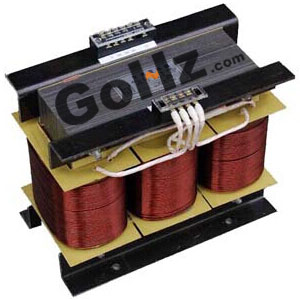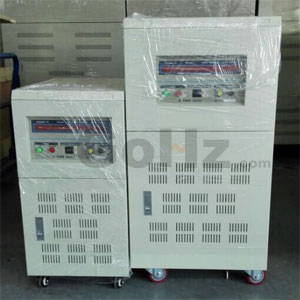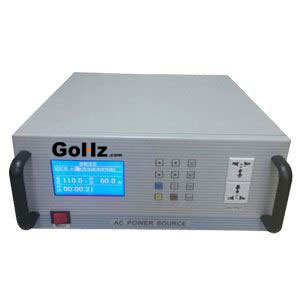Home » AC Power Source » Something about 50Hz 60Hz transformer
Something about 50Hz 60Hz transformer
I hear comments on higher losses at the higher frequency. Derate this, derate that. All this derating talk. Comment after comment. I took some Tempel Steel M6 watts loss curves and turned them into their exponential expressions using log10 juggling to give an expression k*B^n1*f^n2. The equation is 6.1361E-6*(f)^1.6273*B^1.7784. f is in Hz, B is in kGauss. I used the 4kG curve and the 1 kG curve to derive the equation and then tried the equation out at 13.5kG and several frequencies, and it was accurate. From 50 Hz to 60 Hz, if you just plug the 50 Hz and 13.5 kGauss into the equation, and then try the equation with 60 Hz and 50/60 *14 or 11.25 kGauss, W/lb will be .365 and .355, respectively. ===>less watts loss on the core at 60Hz. What else happens?

Your leakage reactance, which limits your short circuit current increases at 60 Hz. For rectifiers, commutation spikes are reduced. For inductive loads, the reactive drop will be slightly greater across the omega*Leakage L (i.e. 377 x L), and directly subtract from the primary voltage that reflects to the secondary. For resistive loads the drop will not be noticeable with a low percentage impedance of a large transformer. On large transformers/distribution size transformers, the % impedance (due to relatively low resistance) is probably a couple of percent to 5%, tops, unless the designer adds shunts to increase the reactance/leakage. On small transformers, in the watts range, the DCR is usually the limiting factor so the leakage affect won't affect short circuit current as noticeably. Net effect- increased leakage for these low frequencies, with resistive loading which puts the leakage L drop in quadrature with the reflected primary load won't add up to a hill of beans of output loss. If the loads are resistive and not rotating devices that are affected by frequency, the transformer will work fine for these loads at 60 Hz. It will have less Ix from increased self-inductance, lowering copper losses (probably very slightly as Ix is in quadrature with load current), and lower core loss. Eddy currents go up, but at 50 Hz to 60 Hz, with oxide insulated lamination to break up the eddy currents, the effect is not of consequence. Yes it will fly. If you go up to, say, 400 Hz, then you will see problems with leakage L. 50Hz to 60Hz-nada.

Your leakage reactance, which limits your short circuit current increases at 60 Hz. For rectifiers, commutation spikes are reduced. For inductive loads, the reactive drop will be slightly greater across the omega*Leakage L (i.e. 377 x L), and directly subtract from the primary voltage that reflects to the secondary. For resistive loads the drop will not be noticeable with a low percentage impedance of a large transformer. On large transformers/distribution size transformers, the % impedance (due to relatively low resistance) is probably a couple of percent to 5%, tops, unless the designer adds shunts to increase the reactance/leakage. On small transformers, in the watts range, the DCR is usually the limiting factor so the leakage affect won't affect short circuit current as noticeably. Net effect- increased leakage for these low frequencies, with resistive loading which puts the leakage L drop in quadrature with the reflected primary load won't add up to a hill of beans of output loss. If the loads are resistive and not rotating devices that are affected by frequency, the transformer will work fine for these loads at 60 Hz. It will have less Ix from increased self-inductance, lowering copper losses (probably very slightly as Ix is in quadrature with load current), and lower core loss. Eddy currents go up, but at 50 Hz to 60 Hz, with oxide insulated lamination to break up the eddy currents, the effect is not of consequence. Yes it will fly. If you go up to, say, 400 Hz, then you will see problems with leakage L. 50Hz to 60Hz-nada.
Post a Comment:
You may also like:
50Hz 60Hz Frequency Converter Setting
Using GoHz frequency converter to
Or customize your own converters.
- Convert 220v 50Hz to 110v 60Hz,
- Convert 120v 60Hz to 230v 50Hz,
- Convert 110v 60Hz to 240v 50Hz,
- Convert 480v 60Hz to 380v 50Hz,
- Convert 400v 50Hz to 460v 60Hz,
- Convert 240v 60Hz to 380v 50Hz,
Or customize your own converters.
Featured Articles
460v 60Hz motor on 400v 50Hz power ...
 Often the European motors at 1hp size are universal for 50Hz or 60Hz power supply, as long as you have 400V x 50Hz and 460V x ...
Often the European motors at 1hp size are universal for 50Hz or 60Hz power supply, as long as you have 400V x 50Hz and 460V x ...
 Often the European motors at 1hp size are universal for 50Hz or 60Hz power supply, as long as you have 400V x 50Hz and 460V x ...
Often the European motors at 1hp size are universal for 50Hz or 60Hz power supply, as long as you have 400V x 50Hz and 460V x ...Convert 220v, 230v, 240v 50Hz to 110v, ...
 When you buy an 110v (120v) 60Hz appliance from USA, and run it on 220v (230v, 240v) 50Hz country (i.e. UK, Australia, ...
When you buy an 110v (120v) 60Hz appliance from USA, and run it on 220v (230v, 240v) 50Hz country (i.e. UK, Australia, ...
 When you buy an 110v (120v) 60Hz appliance from USA, and run it on 220v (230v, 240v) 50Hz country (i.e. UK, Australia, ...
When you buy an 110v (120v) 60Hz appliance from USA, and run it on 220v (230v, 240v) 50Hz country (i.e. UK, Australia, ...60Hz motor running on 50Hz power ...
 Electric motors, both single and three phase, are designed for running on a specified power frequency. But sometimes we may use a ...
Electric motors, both single and three phase, are designed for running on a specified power frequency. But sometimes we may use a ...
 Electric motors, both single and three phase, are designed for running on a specified power frequency. But sometimes we may use a ...
Electric motors, both single and three phase, are designed for running on a specified power frequency. But sometimes we may use a ...